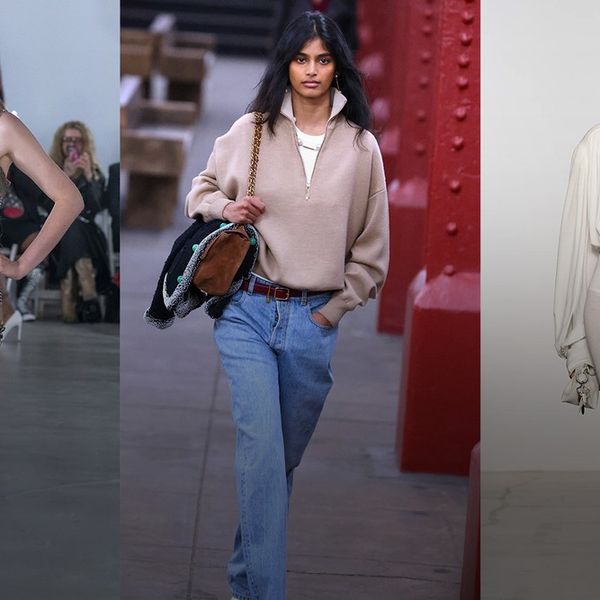Why Fashion Is Going Back to the Future
When even the Met Gala attendees are in vintage, what does that mean for modern fashion?

“It’s kind of goofy,” a New York fashion editor scoffed in response to this year’s Met’s Gala’s "Sleeping Beauties: Reawakening Fashion" theme. “Like: ‘rarest vintage wins.’”
Already the ultimate who’s-who of fashion and culture—with a $75,000 ticket price—this year, the Met has aimed at a new echelon of IYKYK exclusion. Tonight, designs typically monitored by 24-hour security surveillance in temperature-controlled cases will walk onto the red carpet—which is why outlets are running stories elucidating vintage sourcing and online fashion fanatics are making fantasy selects. With bonafide fashion icon Zendaya leading the host call sheet, it will be open season for invitees who fail to unearth exceptional deep cuts—and the fear of faux pas is palpable.
It will not be the first time vintage has graced the Met Gala red carpet en masse. In 2022, Emily Ratajkowski wore a feathered number from Atelier Versace's Spring/Summer 1992 collection, while Billie Eilish appeared in upcycled Gucci. The same year, Kim Kardashian stepped out in the dress Marilyn Monroe wore to serenade President John F. Kennedy in 1962. Haile Lidow, founder of Lidow Archive in Los Angeles, claims vintage styling offers more creative freedom than working directly with designers; a recycled outfit doesn’t have the dual responsibility of advertising a shoppable collection.
“It’s a look for a look’s sake,” Lidow says. “The fact that we are seeing a rise of celebrity-worn vintage is refreshing because it demonstrates a shift in the fashion zeitgeist away from this corporate monopoly and back towards using clothes as a true form of creative expression and artistry.”
This leaves brands in a conundrum. Stars wearing Tom Ford for Gucci likely do not boost the market value of Gucci as much as the popularity of Ford’s Gucci tenure on resale sites—especially when the brand has since gone in a markedly different creative direction.

Emily Ratajkowsk wearing Atelier Versace S/S 1992 at the 2022 Met Gala
Getty Images
While visibility alone may not sell out stores, it’s better than nothing. Even as a current-day Chanel ambassador, Kristen Stweart will routinely wear looks from the brand’s archives according to her stylist Tara Swennen.
“Some of my favorite vintage moments have been on Kristen Stewart,” she says. “We have done a few at the Cannes Film Festival with Chanel that have been divine. We also love to intersperse [vintage] pieces throughout her press tours consistently.”
In the race to meet the demands of modern consumerism, current-day creatives may also not be afforded the creative freedom of their predecessors. Last week, Anya Taylor-Joy went nearly nude to the Furiosa: A Mad Max Saga premiere in a dress and matching helmet crafted from spokes from S/S 96 Paco Rabanne—couture you’d be hard-pressed to find on today’s runways.
Vintage curator Janet Mandell opened her West Hollywood showroom in 2019 due to increasing requests from celebrity stylists. “Sourcing rare, one-of-a-kind runway pieces is truly a task that never sleeps. We curate from a wide variety of sources, such as reseller sites, vintage resellers, peer-to-peer, and boutique shops.”
Like the aforementioned fashion editor, Mandell believes celebrities are trying to “outdo” each other by sourcing one-off archive pieces. Among her regulars are Dani Michelle (Kourtney Kardashian) and Mimi Cuttrell (Gigi Hadid), who have called on Mandell for something unique. As such, it’s imperative her team know the collection inside and out.
“[We share] the stories behind the pieces, who famously wore them, any interesting and unique tidbits about the year or the designer. Some clients and projects will be looking for a very specific era or period.” Mandell says. ”I believe we are heading into [a period of] even more vintage and throwback looks.”
Vogue attributed Met attendees’ 2022 shift to pressure on fashion houses and their ambassadors to opt for eco-friendly alternatives. While Lidow agrees that vintage styling is inarguably more sustainable than custom-made designs, Swennen adds that the significant carbon emissions required to assess, fit, and ultimately procure each piece often go unacknowledged (see: Kim Kardashian’s well-documented private flights to Florida to try on the Marilyn dress).
“[While] of course no production is needed to create any new garments, one always needs to remember though that [travel], shipping, dry cleaning, and things of that sort are always a piece of that puzzle as well,” she says.
For many stars and their stylists, dressing for the red carpet isn’t limited to custom and vintage options. Borrowing from recent seasons is a long-held tradition on red carpets, though the implied lack of budget—or star power—of "ownership" means it's approached with much less transparency. ("It’s on loan from Louis Vuitton!" doesn’t have quite the same ring on the red carpet.)

Billie Eilish in upcycled Gucci at the Met Gala 2022
Getty Images
This is certainly a workaround for fashion fans who uphold that one-of-one vintage should be archived, not worn. Lidow and Mandell alike have contended with horror stories—tears, stains, or "lost" pieces (Mandell is still mourning a rare, vintage Chanel set that was stolen and a delicate Dolce & Gabbana gown that was returned ripped).
“The difficult part of using vintage is that many places tend to be wary of renting since older pieces can be damaged and most regrettably cannot be altered—even temporarily,” explains Swennen. “When receiving loans from designers from current collections, this tends to be less of an issue.”
Now that vintage is mainstream enough to reach the Met, the conflicts facing fashion brands have become unignorable. How can houses prioritize quality control and meet profit margins? How do designers address our desire for nostalgia-inspired newness while still moving the needle forward? How can companies encourage us to consume and authentically commit to environmentalism?
For her part, Lidow considers the resurgence of vintage styles refreshing. “It demonstrates a shift in the fashion zeitgeist away from this corporate monopoly and back towards using clothes as a true form of creative expression and artistry.”
Put simply, “the rarest vintage wins.”
In the meantime, for Met attendees hoping to meet the theme and emerge unscathed, consider letting Emma Stone light the way. While Kim was cosplaying Ms. Monroe, Emma Stone repurposed her Vuitton wedding reception dress for the red carpet. It was an unimpeachable power move—satisfying her brand commitments as an ambassador and the "American Anthology" theme. Maybe, after all the shopping, gifting, and sourcing, the rarest "Sleeping Beauty" lies ready to be awakened in your very own closet.
“Fashion in its truest nature is cyclical, so we should always refer back to the past,” says Swennen. “It truly inspires the future.”




